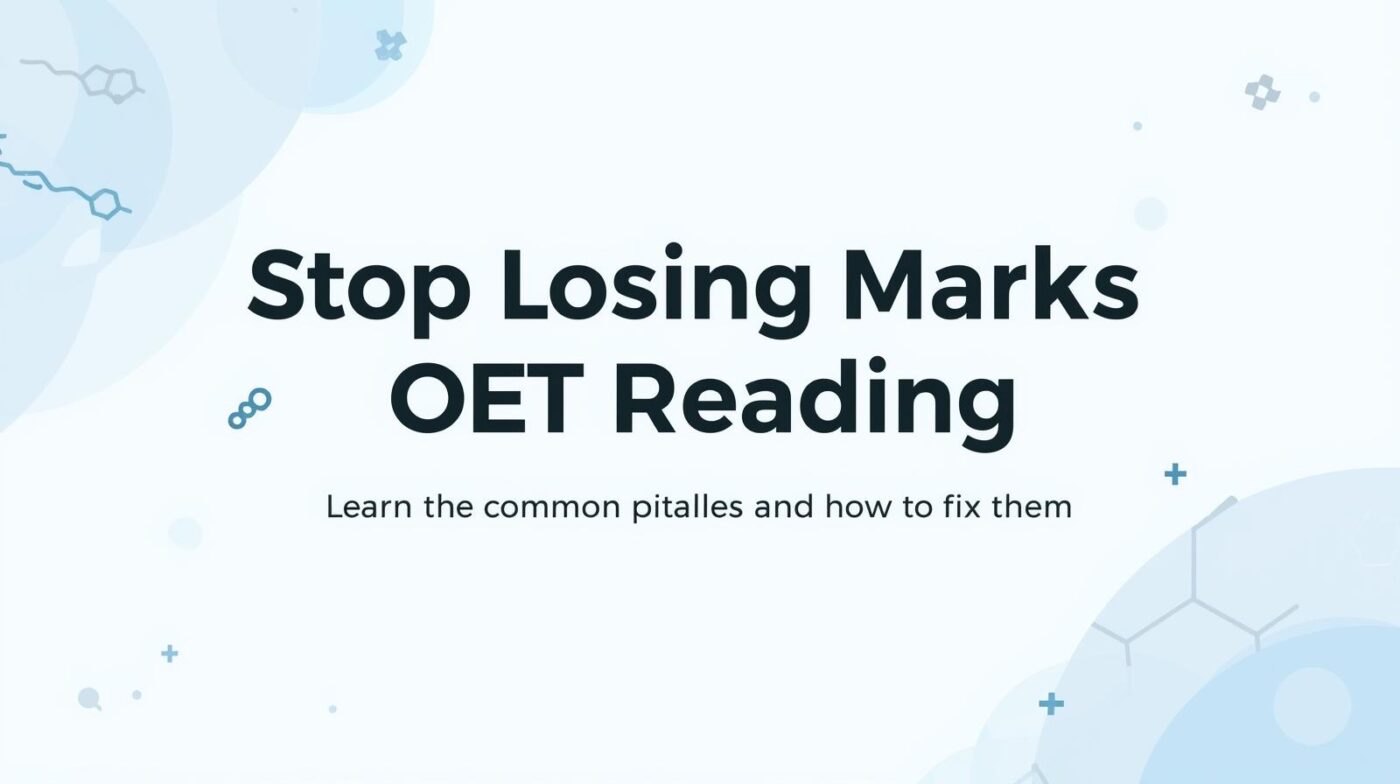OET Strategies, Reading
Common Reasons OET Reading Scores Drop (and How to Fix Them)
Many candidates experience a puzzling drop in their OET Reading score after initially achieving 350 or higher on their first attempt.
Compared to IELTS or TOEFL, OET questions are relatively straightforward and predictable — which can make candidates overconfident.
You might think,
“Reading shouldn’t be a problem…”
But that assumption can backfire. Many IMGs who finally achieve a passing score in Listening end up failing Reading unexpectedly.
Let’s break down why this happens and how to stabilize your Reading score.
Part A Consistency Is the Key
The single most important factor for a stable OET Reading score is Part A performance.
Just like in Listening, Part A contributes heavily to your overall score. It contains the largest number of questions and thus determines the baseline of your results.
Part A primarily tests scanning skills — finding information quickly rather than deeply understanding the text. To do well, you need:
- Strong medical vocabulary
- Sufficient background knowledge of healthcare topics
- Fast and accurate information processing
Among these, background knowledge (also called schema) is often the biggest differentiator.
Candidates from non-medicine fields — such as veterinary or dental backgrounds — may find it harder to stabilize their scores due to unfamiliarity with common hospital topics.
A realistic goal is 16 out of 20 in Part A. Achieving this gives you a buffer if you struggle in Parts B or C.
Start from the Second Task
One useful trick: start Part A from the second question set.
There are three main types of Part A questions:
- Paragraph matching
- Short-answer
- Gap-filling
The paragraph matching task is unique because you answer using letters (A–D). It’s quicker to complete than short-answer or gap-fill questions. If you’re running out of time, you can still finish it within the last minute.
By postponing this question type, you’ll have already read much of the text while answering the other items — meaning you can complete it faster and more accurately when you return to it.
Because Part A lasts only 15 minutes, don’t spend equal time on all questions. Focus your time on the ones that are time-dependent but accuracy-guaranteed (short-answer and gap-filling).
This approach greatly improves reproducibility across test attempts.
When Reading Too Fast Leads to Mistakes
As discussed in previous articles, the most consistent way to approach OET multiple-choice questions is to let the question guide your reading.
Why? Because the answer options often include ideas directly quoted from the text — which can trick your brain into thinking, “Oh, I saw that!” and cause you to select the wrong one.
Candidates whose scores fluctuate tend to skip this careful reading of the question itself. Interestingly, they are often quick thinkers in daily life — people who grasp what someone is saying even before the sentence ends.
You might know the type:
“Ah, I see! So you mean… right?”
It’s a strength in clinical communication — but a weakness in OET Reading. This “fast-processing mode” makes it difficult to slow down and analyze what each question really asks.
The result? Misinterpretation and overconfidence.
Switching Between Skimming and Careful Reading
The solution is to consciously switch between fast and slow reading modes — much like changing gears in a car.
- On the highway, you drive in D (Drive).
- On a steep mountain road, you switch to L (Low) for control.
Reading works the same way.For less important sections, stay in Drive mode — skim quickly. When you encounter a question or a key idea, shift to Low — read slowly and carefully.
When reviewing practice tests, try to visualize the structure of the passage. Ask yourself: Which sentences carry the main point?
The more you practice identifying these “gear change” moments, the more stable your performance becomes.
Aim to Understand in One Read
During review, your goal should be to grasp the meaning of each sentence instantly, without rereading.
Many candidates — especially those trained in exam-style study — unconsciously read a sentence twice: first to decode it, then again to truly understand.
In OET, where you must process long passages quickly, this habit reduces efficiency and consistency.
Instead, train your brain to visualize the meaning as you read. When listening to English, we do the same: as soon as the audio ends, we picture the situation in our mind.
Try reading aloud and imagining the scene instantly after each sentence. Repeating this “pattern practice” helps internalize the structure of medical English and solidify your comprehension speed.
Final Thoughts
Reading in OET isn’t about intellectual understanding — it’s about controlling your processing mode and building reliable habits.
If your scores are unstable, check whether your strategy allows consistent performance, especially in Part A. With structured review and deliberate practice, stability naturally follows.
If you’re preparing for OET, consider exploring our practice resources at OET Bank.
We’re designed not just as mock tests, but as powerful review tools that make it easier to analyze weaknesses and focus on what’s needed to pass.


